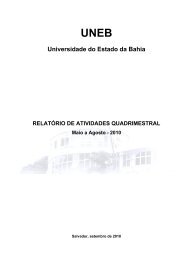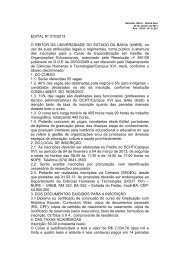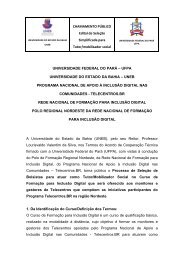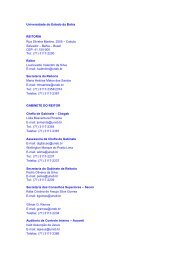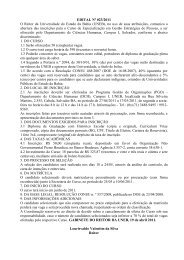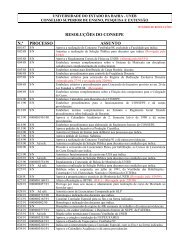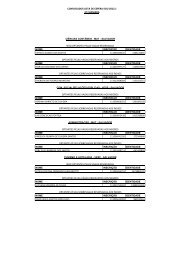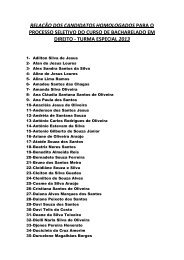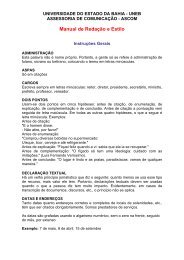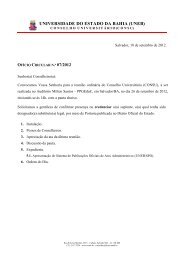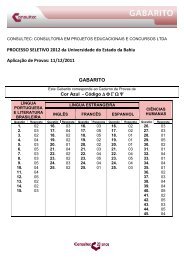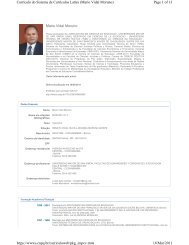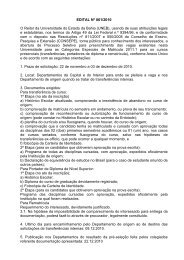Revista da FAEEBA Educação e Contemporaneidade - Uneb
Revista da FAEEBA Educação e Contemporaneidade - Uneb
Revista da FAEEBA Educação e Contemporaneidade - Uneb
Create successful ePaper yourself
Turn your PDF publications into a flip-book with our unique Google optimized e-Paper software.
The black/white racial binary that the U.S.<br />
was founded on – where one drop of “black”<br />
blood makes a person “black” – conflicts with<br />
notions of race that Latinos bring to the U.S.<br />
(RODRÍGUEZ, 2000). Puerto Ricans, among all<br />
Latinos, have felt the impact of racialization in<br />
the U.S. most profoundly. Indeed, different shades<br />
of color within the community have translated<br />
into different experiences (KLOR DE ALVA,<br />
1997; RODRÍGUEZ, 1989). Dark-skinned Puerto<br />
Ricans must confront a society that sees<br />
them first as “black”. Piri Thomas, a Puerto Rican<br />
writer, recounts in his autobiography Down<br />
These Mean Streets his painful discovery of what<br />
it meant to be <strong>da</strong>rk-skinned when he applied for<br />
a sales job. Told that a job is filled, his light-skinned<br />
Puerto Rican friend who applies after him is<br />
hired for the position on the spot.<br />
I didn’t feel so much angry as I did sick, like<br />
throwing-up sick. Later, when I told this story to<br />
my buddy, a colored cat, he said, ‘Hell Piri, Ah<br />
know stuff like that can sure burn a cat up, but a<br />
Negro faces that all the time.’ ‘I know that,’ I<br />
said, ‘but I wasn’t a Negro then. I was still only<br />
a Puerto Rican.’ (1967, p.104)<br />
The racial diversity of the New York Puerto<br />
Rican and Dominican populations, in turn, has<br />
promoted a “more reciprocal and fluid relationship”<br />
(FLORES, 1993, p.183) to African<br />
American culture. The cultural sharing and fusion<br />
that takes place is visible in mainland Puerto<br />
Rican music, <strong>da</strong>nce, and language. Latino<br />
rap for instance creatively comments on these<br />
lived realities in intermingling Spanish and Black<br />
English:<br />
I rarely talk Spanish and a little trigueño<br />
(Spanglish)<br />
People be swearin’ (Black English verb construction)<br />
I’m a moreno (black)<br />
Pero guess what? I’m puertorriqueño.<br />
Word ‘em up.<br />
All jokes aside, I ain’t tryin’ to dis (Black English<br />
phrase equivalent to “disrespect”) any race.<br />
(lyrics by KT, in FLORES, 2000, p.129)<br />
Race is not a fixed biological essence but<br />
rather a set of socially constructed meanings<br />
that vary from one location to another (OMI<br />
and WINANT, 1994). These meanings are sub-<br />
Ellen Bigler<br />
ject to change and contestation, as seen in the<br />
case of the counter-narrative launched by Latina/os<br />
and African American social movements<br />
beginning in the 1960s. “Race” in the U.S. –<br />
with only categories of “white” and now<br />
“nonwhite,” – differs from “race” in the Caribbean<br />
and Latin America, where intermediary<br />
categories exist and “race” is not as fixed (RO-<br />
DRÍGUEZ, 2000). People in the same family<br />
can be classified as different races, depending<br />
on their physical appearance. Changes in dress<br />
or social class can alter perceptions of one’s<br />
race. This fluidity runs counter to American<br />
ways of evaluating race, and the encounter with<br />
American categories can be disorienting for<br />
Latina/os. Jorge Duany, for instance (2003,<br />
p.274), recounts a colleague’s story of how she<br />
moved from being an india clara (literally, a<br />
light Indian) in the Dominican Republic to being<br />
perceived as “black” in the U.S. Dominicans in<br />
the U.S. may choose to emphasize their “dominicanness”<br />
to avoid being taken for African<br />
American (DUANY, 2003). The experience of<br />
living in the U.S., though, can also result in a<br />
greater identification with African Americans,<br />
recognition of their common bonds, and ultimately<br />
greater opportunities for cultural exchange<br />
as both Puerto Ricans and Dominicans live and<br />
interact in close proximity with their urban African<br />
American counterparts. As Duany (2003,<br />
p.283-284) notes: “For many racially mixed immigrants<br />
(from the Caribbean), coming to America<br />
has meant coming to terms with their own,<br />
partially suppressed, sometimes painful, but<br />
always liberating sense of negritude.”<br />
As Puerto Ricans and “Dominican Yorks”<br />
on the mainland participate in these different<br />
realities, they become culturally differentiated<br />
from their Caribbean counterparts. The return<br />
to the idealized homeland can lead to disenchantment<br />
and psychic pain (FLORES, 2000),<br />
as they struggle with the clashes between the<br />
imaginary and the “real,” and the disorienting<br />
identity claims of “here” and “there”.<br />
yo peleo por ti, puerto rico, ¿sabes?<br />
yo me defiendo por tu nombre, ¿sabes?<br />
entro en tu isla, me siento extraño, ¿sabes?<br />
entro a buscar más y más, ¿sabes?<br />
<strong>Revista</strong> <strong>da</strong> <strong>FAEEBA</strong> – <strong>Educação</strong> e Contemporanei<strong>da</strong>de, Salvador, v. 15, n. 25, p. 239-257, jan./jun., 2006 247



